
 DEDICATION This book is dedicated to Elizabeth, Byron and Rachael. Wamlati! ACKNOWLEDGMENTS My sincere thanks to the countless volunteers who have contributed their time, energies and field data to breeding bird atlases, bird counts and other citizen science projects. The collaborative efforts of volunteers and wildlife professionals across North America, as well as globally important migratory wintering areas, provide vital information to the life histories and population status of birds. These resources have been imperative in the writing of the Wild About series of bird books. Carrol Henderson, Supervisor, Minnesota DNR Nongame Wildlife Program: Thank you for reviewing the book and sharing your knowledge of North American birds. Your input has been invaluable.
DEDICATION This book is dedicated to Elizabeth, Byron and Rachael. Wamlati! ACKNOWLEDGMENTS My sincere thanks to the countless volunteers who have contributed their time, energies and field data to breeding bird atlases, bird counts and other citizen science projects. The collaborative efforts of volunteers and wildlife professionals across North America, as well as globally important migratory wintering areas, provide vital information to the life histories and population status of birds. These resources have been imperative in the writing of the Wild About series of bird books. Carrol Henderson, Supervisor, Minnesota DNR Nongame Wildlife Program: Thank you for reviewing the book and sharing your knowledge of North American birds. Your input has been invaluable.
Friends, the neighborhood gang, and the teachers and students who shared their ideas and support: Thank you for your incredible enthusiasm and imaginative input. Helen and John Scuffhams Garden, Helens Gourd Creations: Thank you for providing/preparing the incredible gourds for the feeders and for sharing your creative talents. Cover and book design by Jonathan Norberg Photo credits by photographer and page number: Front cover photos: Banana Split, Happy Bird-day Cake, Sunflower Snack, Festive Outdoor Appetizers by Alan Stankevitz; appl-icious Crumble Pie by Jonathan Norberg Back cover photos: Banana Split and Double-dipped Cone by Alan Stankevitz, Red-headed Woodpecker by Stan Tekiela Jonathan Norberg: (Red-headed Woodpecker) The following Shutterstock images are by the photographers noted: Al Mueller: Black-capped Chickadee, pgs. 10 9 8 7 6 5 4 3 2 1 Homemade Bird Food: 26 Fun & Easy Recipes to Feed Backyard Birds First Edition 2010 (entitled Cooking for the Birds), Second Edition 2020 Copyright 2010 and 2020 by Adele Porter Published by Adventure Publications An imprint of AdventureKEEN 330 Garfield Street South Cambridge, Minnesota 55008 (800) 678-7006 www.adventurepublications.net All rights reserved Printed in China ISBN 978-1-59193-717-3 (pbk.)  Table of Contents Make Bird Food at Home If you are wild about birds, then Homemade Bird Food will guide you in planning, preparing and hosting a backyard banquet for the birds. Designed for the entire family (ages 5105), the 26 easy recipes in this book provide a banquet of nutritious food choices for a wide variety of backyard birdsfrom robins, woodpeckers and hummingbirds to chickadees and more! Once your buffet is served, sit back and enjoy the festivities. Contribute the information about the birds in your backyard, school yard or urban setting to a citizen science project that works toward the stewardship of our limited natural resources.
Table of Contents Make Bird Food at Home If you are wild about birds, then Homemade Bird Food will guide you in planning, preparing and hosting a backyard banquet for the birds. Designed for the entire family (ages 5105), the 26 easy recipes in this book provide a banquet of nutritious food choices for a wide variety of backyard birdsfrom robins, woodpeckers and hummingbirds to chickadees and more! Once your buffet is served, sit back and enjoy the festivities. Contribute the information about the birds in your backyard, school yard or urban setting to a citizen science project that works toward the stewardship of our limited natural resources.
HOW TO USE THIS BOOK Backyard bird feeding is like hosting a dinner party for wildlife. There are several stages involved in planning and implementing the whole affair. These stages are described in the following sections. Set the Table for Success with an understanding of the foods birds eat, how food preferences vary by bird species and how a birds nutritional needs vary according to season. Cooking Basics will help you learn the basic ingredients of bird feeding. Arrange the Dining Room with the help of tips for creating a backyard or urban habitat that attracts and meets the needs of wildlife.
Then, create your banquet guest list from the seating chart. Invite the Guests: Prepare the Menu by reviewing this list of the 75 most common North American backyard birds. This list is arranged by bird order and identifies the foods that each species is most attracted to in a feeder setting. It also identifies the region of the United States where the birds are most likely to inhabit. From this list you can plan your banquet menu by selecting the bird species you desire to attract and then preparing a recipe that matches the ingredients, or you can simply whip up a favorite recipe and prepare for guests to arrive. Recipe Review provides a sample recipe to help you know what to expect.
Kids in the Kitchen features handy advice and safety tips for cooking when kids are in the kitchen. Teaming Up: Citizen Science and Environmental Awareness are important, so once your banquet is served, find a comfortable seat and put on your citizen-science hat. You can be a part of ongoing science by contributing your bird information to a project sponsored by such groups as the National Audubon Society, the Cornell Lab of Ornithology and more. Chef Notes at the end of this book are yours to fill in. You can keep track of the birds that are attracted to particular recipes, note changes youve made to a recipe, and create your own recipes from the ingredients list. Homemade Bird Food blends kitchen and backyard science into a banquet of fun for wildlife enthusiasts of all ages. Homemade Bird Food blends kitchen and backyard science into a banquet of fun for wildlife enthusiasts of all ages.
Let the feast begin! SET THE TABLE FOR SUCCESS Bird feeding is both a craft and a science. It can be as simple as setting out a sock feeder of thistle seeds and watching finches and chickadees feast. It may be as involved as understanding bird biology and the life histories of different species and then setting up feeders to attract specific birds in each season. This involves a full menu: insects for wrens, warblers and creepers; suet for nuthatches and woodpeckers; fruit for mockingbirds, orioles, cardinals and robins; acorns and other nuts scattered on the ground for Wild Turkeys and jays; and nectar for hummingbirds. Bird feeding does not provide for a birds total nutritional needs, but it supplements their diet of foods gained from the natural environment. This can be helpful during harsh winters.
Black-capped Chickadees have been found to gain just over 20% of their overall nutrition from feeders. By setting up feeders and landscaping with plants that host natural food sources for wildlife, your yard can be an important part of providing for the basic needs of wildlife. Seasonal Favorites Each season provides an opportunity to set out food items that are suited to the specific needs of birds. For instance, neotropical migratory birds often feed on fruit in their South American winter homes, and when they come north to nest in North America they take advantage of the summer increase in mineral and protein-packed insects to fuel their chicks fast growth. WINTER: Birds that overwinter in the northern United States require high-calorie foods to produce enough heat to survive and to gain as many calories as possible while expending the least amount of energy. Fats and carbohydrates in the form of suet and nuts are on the winter menu along with calorie-laden sunflower and safflower seeds.
Offering shelled nuts and seeds will also save birds the effort of opening the seeds. SPRING/FALL: Fueling Migration The migratory movements of birds are triggered by changes in the length of daylight. During migration, birds produce additional hormones, allowing them to store energy in extra fat deposits; this energy is needed to fuel migratory flight. Migration is also the time of year when the widest variety of bird species pass through many areas. Provide a wide variety of food types and sizes at all habitat levels to attract these migrating birds. In the spring, provide warblers with mealworms, and set out fruit, jelly, and nectar for orioles, catbirds and robins, along with the regular menu of seeds and nuts.
Next page
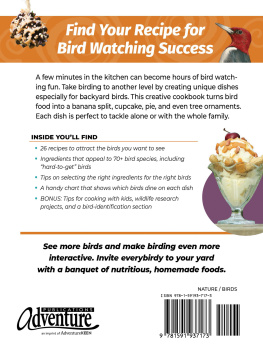

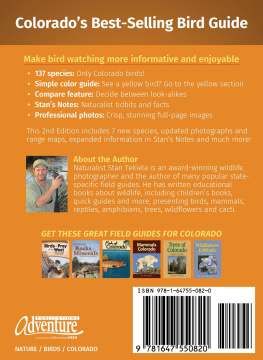
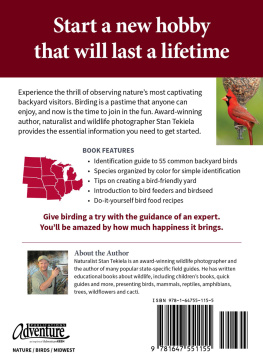
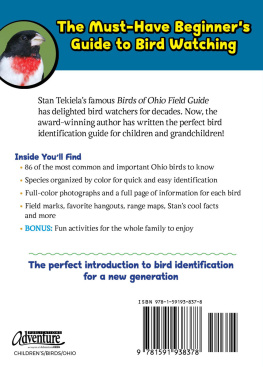
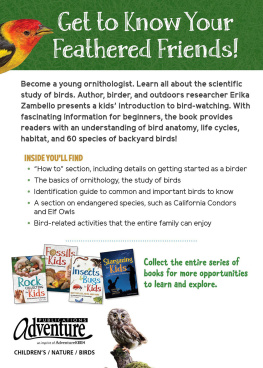

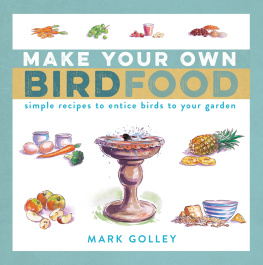
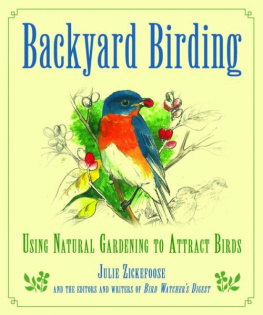
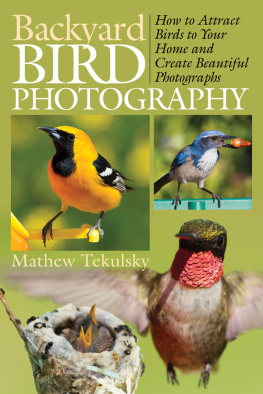

 DEDICATION This book is dedicated to Elizabeth, Byron and Rachael. Wamlati! ACKNOWLEDGMENTS My sincere thanks to the countless volunteers who have contributed their time, energies and field data to breeding bird atlases, bird counts and other citizen science projects. The collaborative efforts of volunteers and wildlife professionals across North America, as well as globally important migratory wintering areas, provide vital information to the life histories and population status of birds. These resources have been imperative in the writing of the Wild About series of bird books. Carrol Henderson, Supervisor, Minnesota DNR Nongame Wildlife Program: Thank you for reviewing the book and sharing your knowledge of North American birds. Your input has been invaluable.
DEDICATION This book is dedicated to Elizabeth, Byron and Rachael. Wamlati! ACKNOWLEDGMENTS My sincere thanks to the countless volunteers who have contributed their time, energies and field data to breeding bird atlases, bird counts and other citizen science projects. The collaborative efforts of volunteers and wildlife professionals across North America, as well as globally important migratory wintering areas, provide vital information to the life histories and population status of birds. These resources have been imperative in the writing of the Wild About series of bird books. Carrol Henderson, Supervisor, Minnesota DNR Nongame Wildlife Program: Thank you for reviewing the book and sharing your knowledge of North American birds. Your input has been invaluable. Table of Contents Make Bird Food at Home If you are wild about birds, then Homemade Bird Food will guide you in planning, preparing and hosting a backyard banquet for the birds. Designed for the entire family (ages 5105), the 26 easy recipes in this book provide a banquet of nutritious food choices for a wide variety of backyard birdsfrom robins, woodpeckers and hummingbirds to chickadees and more! Once your buffet is served, sit back and enjoy the festivities. Contribute the information about the birds in your backyard, school yard or urban setting to a citizen science project that works toward the stewardship of our limited natural resources.
Table of Contents Make Bird Food at Home If you are wild about birds, then Homemade Bird Food will guide you in planning, preparing and hosting a backyard banquet for the birds. Designed for the entire family (ages 5105), the 26 easy recipes in this book provide a banquet of nutritious food choices for a wide variety of backyard birdsfrom robins, woodpeckers and hummingbirds to chickadees and more! Once your buffet is served, sit back and enjoy the festivities. Contribute the information about the birds in your backyard, school yard or urban setting to a citizen science project that works toward the stewardship of our limited natural resources.